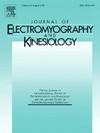Thoracic paraspinal muscle concentric needle electrode jitter analysis in electrophysiological diagnosis of ALS
IF 2.3
4区 医学
Q3 NEUROSCIENCES
引用次数: 0
Abstract
Objectives
Jitter analysis with concentric needle electrode of the thoracic 9 (T9) paraspinal muscle (PM), where the needle EMG examination at rest is difficult, was performed in both amyotrophic lateral sclerosis (ALS) patients and the controls.
Methods
For the T9 PM, both upper limit for mean and individual mean consecutive difference (MCD) values and spike numbers were calculated according to jitter values of pairs from controls. In addition to the descriptive statistics, differences between two groups and T9 PM needle EMG and jitter analysis findings of patients were compared (p = 0.05).
Results
Mean MCD median values of T9 PM were 62.8 and 26.2 µs in patient and controls respectively. Upper limit of mean and individual MCDs for the T9 PM were determined as 36.95 μs, 57.95 μs respectively. The differences between controls and patients in terms of all jitter analysis parametres (p < 0.001) and the comparison of patients’ T9 PM needle EMG and jitter analysis findings grading were statistically significant (p = 0.029).
Conclusion
The T9 PM jitter analysis performed during routine EMG can be used to support the electrophysiological diagnosis of ALS in challenging cases and may contribute to minimizing the number of muscles examined. Furthermore, our study contributed to the T9 PM reference values for jitter analysis.
胸椎棘旁肌同心针电极抖动分析在肌萎缩侧索硬化症电生理诊断中的应用。
目的:对肌萎缩性侧索硬化症(ALS)患者和对照组进行静息时针肌电图检查困难的胸椎9 (T9)棘旁肌(PM)同心针电极的抖动分析。方法:根据对照对的抖动值计算T9 PM的平均和个体平均连续差(MCD)值的上限和尖峰数。除描述性统计外,比较两组患者T9 PM针肌电图及抖动分析结果的差异(p = 0.05)。结果:患者和对照组T9 PM的平均MCD中位数分别为62.8和26.2µs。T9 PM的平均和个体mcd上限分别为36.95 μs和57.95 μs。结论:常规肌电图中进行的T9 PM抖动分析可用于支持挑战性病例中ALS的电生理诊断,并可能有助于减少检查肌肉的数量。此外,我们的研究为抖动分析提供了T9 PM参考值。
本文章由计算机程序翻译,如有差异,请以英文原文为准。
求助全文
约1分钟内获得全文
求助全文
来源期刊
CiteScore
4.70
自引率
8.00%
发文量
70
审稿时长
74 days
期刊介绍:
Journal of Electromyography & Kinesiology is the primary source for outstanding original articles on the study of human movement from muscle contraction via its motor units and sensory system to integrated motion through mechanical and electrical detection techniques.
As the official publication of the International Society of Electrophysiology and Kinesiology, the journal is dedicated to publishing the best work in all areas of electromyography and kinesiology, including: control of movement, muscle fatigue, muscle and nerve properties, joint biomechanics and electrical stimulation. Applications in rehabilitation, sports & exercise, motion analysis, ergonomics, alternative & complimentary medicine, measures of human performance and technical articles on electromyographic signal processing are welcome.

 求助内容:
求助内容: 应助结果提醒方式:
应助结果提醒方式:


